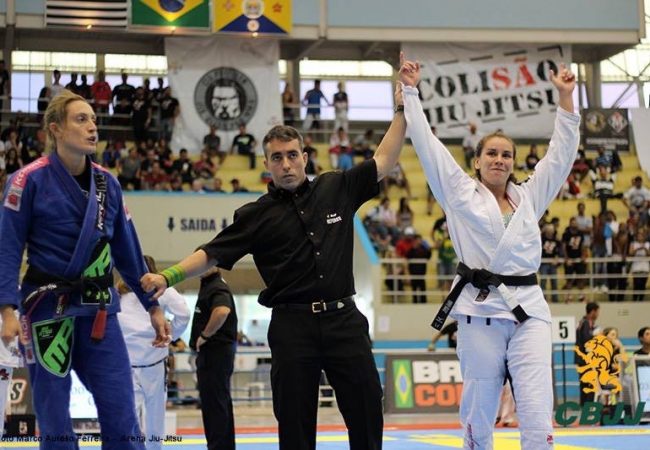
Black-belt Rodrigo Totti refereeing. CBJJ
After the close of the 2018 Worlds on June 3rd, the IBJJF again updated its rulebook aiming at clearer interpretations of fights with the best options for competitors and refs.
The new rules will take effect on July 2nd for all competitions held by the IBJJF and its representatives worldwide, and you can get the full list by clicking here.
For comment on the alterations, Graciemag talked to Gabriel Costa, refereeing director for the federation and 3rd-degree black-belt.
“Many teachers bring ideas, often problems in matches, and the refs also bring up some tough combat scenarios,” he said. “These possible difficulties in evaluating the fight, or problems of the sport’s evolution, like the one brought about by the double pull, are analyzed, and the possible solutions are presented to teachers and team leaders before we make a decision about the subject and a change, adaptation or new interpretation of a rule.”
In one of the changes pointed out, Gabriel talks about the third simultaneous foul, where two athletes are penalized for stalling. The new rule says that in situations where both athletes are penalized for lack of combativeness resulting in their third penalty, the fight will resume standing. Gabriel adds: “When both are stalling, the intent is to change the course of the fight to avoid them both getting disqualified.”
Below, Gabriel points out the main rule changes, with comments to better illustrate the scenario each rule fits and why it’s been adapted.
4.1.5 – While in any position starting from guard, where the athletes remain on their feet for 3
seconds, the combat shall then be considered standing combat.
Note: In order to start the 3-second countdown, one of the athletes must have two feet on the
ground and the opponent at least one foot on the ground without the knee of the opposite leg
touching the mat.
Comment: Often, after getting up during the sweep motion, the fight would stay on the feet for some time and the athlete defending against the motion would take down their opponent and get no points. It was unfair not to give any points to the athlete achieving a takedown.
5.6.2 Advantage from Guard Pass – When the athlete passing guard stacks the opponent, or allows the opponent to roll back
his/herself, controlling the opponent’s back in four-point-kneeling position and maintaining at
least one knee on the ground, without needing to place hooks.
Comment: This advantage used to only be obtained if the motion were initiated by the guard player to avoid the guard pass. With this tweak, this advantage will be granted even if the passer forces the stacking and rushes to the back.
5.7 Specific cases whereby advantages are no longer awarded.
5.7.1 – The half-guard position shall not count for an advantage for the athlete on top if it did not
originate from a guard- pass attempt.
Comment: Achieving the position will be necessary, and this advantage will no longer be given if the athlete is on half-guard. The athlete will get the advantage in cases like the guard being recovered, the fight ending, or similar situations, and will no longer get the advantage when they complete the pass or when, coming from a sweep, they land on half-guard.
5.7.5 – No advantage shall be awarded when an athlete attempting a single-leg takedown traps
the opponent’s leg and drags the opponent to outside the combat area, obliging the referee to
interrupt the combat.
Comment: It made no sense to reward an athlete for attempting to leave the combat area. To score a takedown advantage, the athlete at least needs to take down their opponent within the combat area.
6.2.2 Serious Fouls
t) When an athlete takes more than 20 seconds to re-adjust their(his/her) uniform, they shall be
penalized in a consecutive manner (20 seconds for Gi top and belt, 20 seconds for identification
belt, and 20 seconds for tying the drawstring of the pants, when necessary)
Comment: Now, the act of tying one’s pants’ drawstrings will be monitored (many athletes would take their time doing it and cool the fight down), and if the athlete tries to use this time to rest, they will continue to be penalized every 20 seconds.
w) When, in the under-15-year-old-division (for all belts) and in all white belt age groups, an
athlete jumps for closed guard on a standing opponent, including any and all attacks initiated by
jumping guard, such as but not limited to Flying Triangles and Flying Armbars. When such
moves occur, the referee will stand both athletes up again.
Note: Should one athlete be defending an attempted takedown or sweep and jump guard, the
punishment shall include 2 points being awarded to the opponent.
Comment: This restriction was only for white-belts, but starting now, it’s added to all age groups up to 15 years old, thus preventing injuries in all kids’ divisions.
x) When an athlete during a match or celebrating victory before being announced as the winner
exhibits attitudes not appropriate for the competition environment, but does not qualify as a
disciplinary penalty as described in item 6.1.
Ex: Gestures or exercises meant to suggest physical superiority, dances or attitudes meant to
ridicule within a sporting context.
Comment: There was the need to correct some unnecessary attitudes that were not bad enough to warrant a DQ.
The post IBJJF talks about changes and new rules first appeared on Graciemag.
